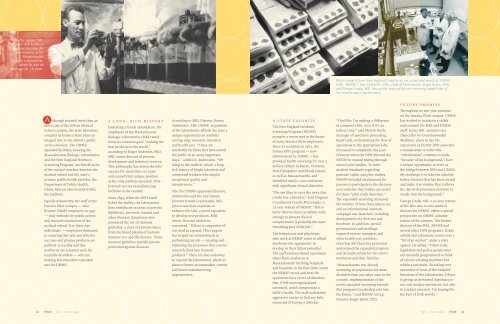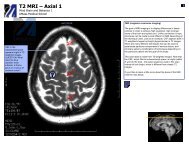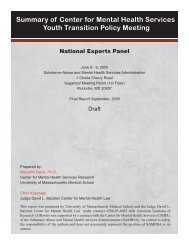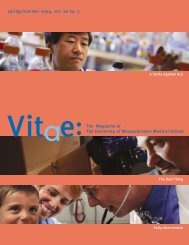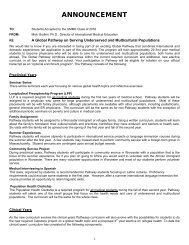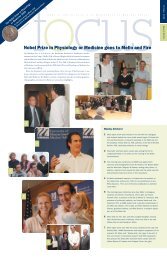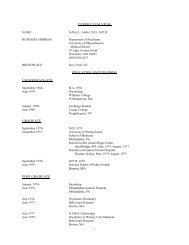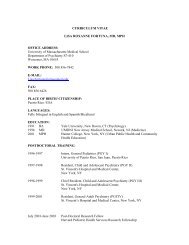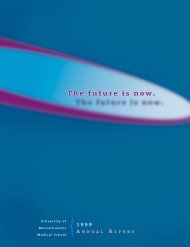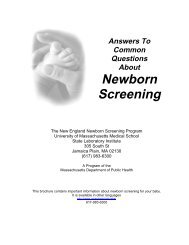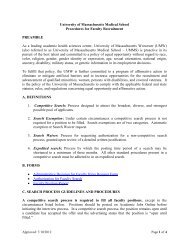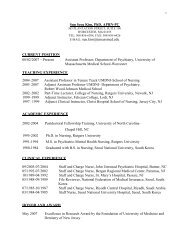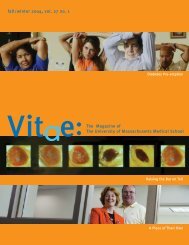à UMass fall / printer - the University of Massachusetts Medical School
à UMass fall / printer - the University of Massachusetts Medical School
à UMass fall / printer - the University of Massachusetts Medical School
You also want an ePaper? Increase the reach of your titles
YUMPU automatically turns print PDFs into web optimized ePapers that Google loves.
In <strong>the</strong> 1950s, “Mr.<br />
Tetanus” Bill Lentham<br />
prepares <strong>the</strong> virus for<br />
vaccinations at <strong>the</strong><br />
<strong>Massachusetts</strong><br />
Biologic Laboratories,<br />
where he was an<br />
employee for 36 years.<br />
Blood samples from New England’s newborns are sorted and stored at NENSP<br />
(left). NENSP’s Tom Zytkovicz, PhD, chief <strong>of</strong> laboratories; Roger Eaton, PhD;<br />
and George Grady, MD, discuss <strong>the</strong> state-<strong>of</strong>-<strong>the</strong>-art screening capabilities <strong>of</strong><br />
<strong>the</strong> tandem mass spectrometer.<br />
future promise<br />
a<br />
lthough situated more than 40<br />
miles east <strong>of</strong> <strong>the</strong> <strong>UMass</strong> <strong>Medical</strong><br />
<strong>School</strong> campus, <strong>the</strong> state laboratory<br />
complex in Jamaica Plain plays an<br />
integral role in <strong>the</strong> school’s public<br />
service mission. The UMMSoperated<br />
facilities, housing <strong>the</strong><br />
<strong>Massachusetts</strong> Biologic Laboratories<br />
and <strong>the</strong> New England Newborn<br />
Screening Program, are beneficiaries<br />
<strong>of</strong> <strong>the</strong> natural interface between <strong>the</strong><br />
medical school and <strong>the</strong> state’s<br />
primary public health provider, <strong>the</strong><br />
Department <strong>of</strong> Public Health,<br />
whose labs are also located within<br />
<strong>the</strong> facilities.<br />
Equally noteworthy, <strong>the</strong> staff at <strong>the</strong><br />
Jamaica Plain campus — who<br />
became UMMS employees in 1997<br />
— truly embody <strong>the</strong> public service<br />
and research aspirations <strong>of</strong> <strong>the</strong><br />
medical school. It is <strong>the</strong>se 240<br />
individuals — employees dedicated<br />
to ensuring that safe and effective<br />
vaccines and plasma products are<br />
publicly accessible and that<br />
newborns are screened early for<br />
treatable disorders — who are<br />
making this transition a positive<br />
one for UMMS.<br />
a long, rich history<br />
Projecting a family atmosphere, <strong>the</strong><br />
employees <strong>of</strong> <strong>the</strong> <strong>Massachusetts</strong><br />
Biologic Laboratories (MBL) work<br />
toward a common goal: “making <strong>the</strong><br />
best products in <strong>the</strong> world,”<br />
according to Roger Anderson, PhD,<br />
MBL senior director <strong>of</strong> process<br />
development and technical services.<br />
This philosophy has driven <strong>the</strong> labs’<br />
success for more than 100 years<br />
and created <strong>the</strong>ir unique position<br />
as <strong>the</strong> only publicly-operated, FDAlicensed<br />
vaccine manufacturing<br />
facilities in <strong>the</strong> country.<br />
Since 1894, when <strong>the</strong> DPH established<br />
<strong>the</strong> facility, <strong>the</strong> laboratories<br />
have introduced vaccines to prevent<br />
diph<strong>the</strong>ria, pertussis, tetanus and<br />
o<strong>the</strong>r diseases. Employees also<br />
pioneered <strong>the</strong> use <strong>of</strong> immune<br />
globulins, a class <strong>of</strong> proteins taken<br />
from <strong>the</strong> blood plasma <strong>of</strong> humans<br />
immune to a specific disease. These<br />
immune globulins provide passive<br />
protection against diseases.<br />
According to MBL Director Donna<br />
Ambrosino, MD, UMMS’ acquisition<br />
<strong>of</strong> <strong>the</strong> laboratories affords <strong>the</strong> state a<br />
unique opportunity to combine<br />
cutting-edge research, education<br />
and health care. “These are<br />
wonderful facilities that have served<br />
<strong>the</strong> public in so many important<br />
ways,” noted Dr. Ambrosino. “We<br />
bring to <strong>the</strong> medical school a long,<br />
rich history <strong>of</strong> bright scientists and<br />
committed workers who display<br />
exceptional quality and<br />
inventiveness.”<br />
The first UMMS-appointed director,<br />
Ambrosino said she and Deputy<br />
Director Jeanne Leszczynski, MD,<br />
plan to use <strong>the</strong>ir expertise to<br />
enhance <strong>the</strong> labs’ current capacities<br />
to develop new products. MBL<br />
Senior Director Anderson<br />
concurred. “<strong>UMass</strong> is supportive <strong>of</strong><br />
our need to expand. This support<br />
has helped me tremendously in<br />
performing my job — creating and<br />
validating <strong>the</strong> processes that convert<br />
research ideas into licensed<br />
products.” Plans are also underway<br />
to expand <strong>the</strong> laboratories’ physical<br />
plant to better accommodate current<br />
and future manufacturing<br />
opportunities.<br />
a staff favorite<br />
The New England Newborn<br />
Screening Program (NENSP)<br />
occupies a warm spot in <strong>the</strong> hearts<br />
<strong>of</strong> many Jamaica Plain employees.<br />
Since its inception in 1962, <strong>the</strong><br />
former DPH program — now<br />
administered by UMMS — has<br />
provided health screening for over 3<br />
million infants in Maine, Vermont,<br />
New Hampshire and Rhode Island,<br />
as well as <strong>Massachusetts</strong>, and<br />
identified nearly 2,000 newborns<br />
with significant clinical disorders.<br />
“No one likes to carry <strong>the</strong> news that<br />
a baby has a disorder,” said Program<br />
Coordinator Cecelia McGonagle, a<br />
23-year veteran <strong>of</strong> NENSP. “But to<br />
know that we detect problems early<br />
enough to prevent clinical<br />
complications is probably <strong>the</strong> most<br />
rewarding part <strong>of</strong> <strong>the</strong> job.”<br />
The technicians and physicians<br />
who work at NENSP strive to afford<br />
newborns <strong>the</strong> opportunity to<br />
develop to <strong>the</strong>ir fullest potential.<br />
The staff analyzes blood specimens<br />
taken from newborns at<br />
<strong>Massachusetts</strong>’ birthing hospitals<br />
and hospitals in <strong>the</strong> four o<strong>the</strong>r states<br />
<strong>the</strong> NENSP serves and tests <strong>the</strong><br />
specimens for a series <strong>of</strong> disorders<br />
that, if left unrecognized and<br />
untreated, could compromise a<br />
child’s health. The staff undertakes<br />
aggressive tactics to find any baby<br />
suspected <strong>of</strong> having a disorder.<br />
“I feel like I’m making a difference<br />
in someone’s life, even if it’s an<br />
indirect one,” said Melody Rush,<br />
manager <strong>of</strong> specimen processing.<br />
Rush’s job, orchestrating <strong>the</strong> flow <strong>of</strong><br />
specimens to <strong>the</strong> appropriate labs,<br />
increased in complexity this past<br />
February when <strong>the</strong> DPH directed <strong>the</strong><br />
NENSP to expand testing through<br />
several pilot studies. To meet<br />
modern standards regarding<br />
patients’ rights and pilot studies,<br />
NENSP included mechanisms for<br />
parents to participate in <strong>the</strong> decision<br />
as to whe<strong>the</strong>r <strong>the</strong>ir babies are tested<br />
for <strong>the</strong>se “pilot study disorders.”<br />
The expanded screening increased<br />
<strong>the</strong> number <strong>of</strong> tests from nine to 30,<br />
and an informational outreach<br />
campaign was launched, including<br />
development <strong>of</strong> a Web site and<br />
brochure. In addition, special<br />
presentations and mailings<br />
targeted nursery managers and<br />
o<strong>the</strong>r health care providers,<br />
ensuring that <strong>the</strong>se key personnel<br />
understood <strong>the</strong> expanded program<br />
and its implications for <strong>the</strong> state’s<br />
newborns and <strong>the</strong>ir families.<br />
“<strong>Massachusetts</strong> was already<br />
screening its population for more<br />
disorders than any o<strong>the</strong>r state in <strong>the</strong><br />
country; implementation <strong>of</strong> <strong>the</strong><br />
newly expanded screening extends<br />
this program’s leadership role into<br />
<strong>the</strong> future,” said NENSP Acting<br />
Director Roger Eaton, PhD.<br />
Throughout its two-year presence<br />
on <strong>the</strong> Jamaica Plain campus, UMMS<br />
has worked to maintain a stable<br />
environment for MBL and NENSP<br />
staff. James Hill, assistant vice<br />
chancellor for Commonwealth<br />
Medicine, plans to use his<br />
experience as former DPH associate<br />
commissioner to make this<br />
“cohabitation” continue to work.<br />
“Because <strong>of</strong> my background, I have<br />
a unique opportunity to serve as<br />
<strong>the</strong> bridge between DPH and UMMS.<br />
My challenge is to take <strong>the</strong> administrative<br />
structure that has been created<br />
and make it so routine that it allows<br />
<strong>the</strong> day-to-day business function to<br />
recede into <strong>the</strong> background.”<br />
George Grady, MD, a 30-year veteran<br />
<strong>of</strong> <strong>the</strong> labs who is now medical<br />
director for NENSP, <strong>of</strong>fers a special<br />
perspective on UMMS’ administration<br />
<strong>of</strong> <strong>the</strong> campus. The former<br />
director <strong>of</strong> <strong>the</strong> MBL, NENSP and<br />
several o<strong>the</strong>r DPH programs, Grady<br />
admits that laboratory science was a<br />
“bit <strong>of</strong> an orphan” under a state<br />
agency. He added, “Historically,<br />
legislators and policy people were<br />
not mentally programmed to think<br />
<strong>of</strong> science existing anywhere but<br />
within a university. By taking over<br />
operation <strong>of</strong> most <strong>of</strong> <strong>the</strong> complex<br />
functions <strong>of</strong> <strong>the</strong> laboratories, <strong>UMass</strong><br />
is giving us presumed legitimacy to<br />
not only analyze specimens, but also<br />
to conduct research. I’m hoping for<br />
<strong>the</strong> best <strong>of</strong> both worlds.”<br />
12 Vitae <strong>fall</strong> - winter 1999<br />
<strong>fall</strong> - winter 1999 Vitae 13


